Remember the ABA: Memphis Tams (original) (raw)
Back to "Remember the ABA" Main Page
Did you see a Memphis Tams game? Or, did you have a favorite Tams player? Contribute to this web page by describing your favorite ABA Memphis memories.
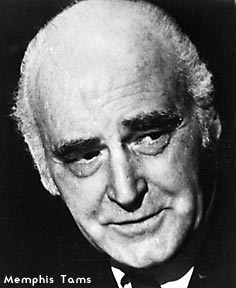 The Memphis Tams only lasted two years (1972-73 and 1973-74) But, even during this short time period, the Tams proved over and over again that they were one of the most bizarre teams in professional basketball history.
The Memphis Tams only lasted two years (1972-73 and 1973-74) But, even during this short time period, the Tams proved over and over again that they were one of the most bizarre teams in professional basketball history.
Thirty years later, it is unusual to find anybody who actually attended a Tams home game - the team had significant attendance problems. Those die-hard Memphis basketball fans who did venture out to see the Tams came away with some truly unique and strange memories.
The story of the Memphis Tams started with the demise of the Memphis Pros. After moving to Memphis from New Orleans, the franchise was saddled with severe financial restrictions and struggled to retain its few talented players. It lost stars and fan favorites such as Jimmy Jones, Steve Jones and Gerald Govan. After a disappointing 1971-72 season, the Pros also lost their longtime coach, Babe McCarthy, and appeared to be headed to the ABA graveyard. However, a "savior" suddenly appeared in the form of Charles O. Finley (at left).
Finley was the owner of the Oakland A's major league baseball dynasty (the A's made the World Series in both 1973 and 1974). He also owned a pro hockey team - the California Golden Seals of the NHL. Finley purchased the Pros and decided to keep the team in Memphis. At first, this was cause for celebration - Finley had money, and he promised the citizens of Memphis that he would provide the financial support needed to make Memphis a strong and stable ABA franchise.
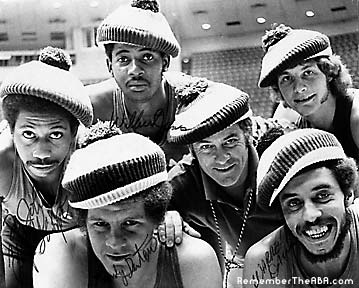 To accentuate the "new" direction of the team, Finley held a special contest to find a better team nickname. Over 20,000 postcards were received during the course of the contest. The winner collected a $2,500 prize for coming up with the dubious nickname, "TAMS." Finley thought the new nickname was appropriate because the Memphis franchise supposedly had fans in [T]ennessee, [A]rkansas, and [M]ississippi. Finley wasted no time in making the Tams the most "colorful" team in the league. The logo of the team became a strange green, white, and gold tam-o-shanter (above). The colors were meant to mimic the colors of the Oakland A's (and the NHL Golden Seals) - Finley wanted a consistent image for his sports "empire," even though the Tams were several thousand miles away from his California teams.
To accentuate the "new" direction of the team, Finley held a special contest to find a better team nickname. Over 20,000 postcards were received during the course of the contest. The winner collected a $2,500 prize for coming up with the dubious nickname, "TAMS." Finley thought the new nickname was appropriate because the Memphis franchise supposedly had fans in [T]ennessee, [A]rkansas, and [M]ississippi. Finley wasted no time in making the Tams the most "colorful" team in the league. The logo of the team became a strange green, white, and gold tam-o-shanter (above). The colors were meant to mimic the colors of the Oakland A's (and the NHL Golden Seals) - Finley wanted a consistent image for his sports "empire," even though the Tams were several thousand miles away from his California teams.
The Tams made their debut on October 12, 1972, losing a 109-105 battle to the defending champion Indiana Pacers before an impressive opening night crowd of 4,593. George Thompson poured in 34 points to keep the Tams close.
At this game, all of the Tams and new coach Bob Bass pranced onto the floor wearing white, green, and gold tams on their heads (see photo above right - clockwise from left, we have Thompson, Randy Denton, Warren Davis, Loyd King, Coach Bass, and Wil Jones). The team's 15 usherettes, 10 cheerleaders, and the Coliseum's regular staff of vendors and gate crewmen also wore the colors.
The players' uniforms were also quite a sight to behold. The Tams had green, gold, and white tops, plus green, gold, and white trunks. During the 1972-73 season, Finley had the team wear these colors in all possible combinations. Some of the combinations were unbearably ugly--for example, at home the Tams sometimes wore their white tops with their green trunks. On the road, it was even worse when the Tams wore their green shirts with their white trunks.
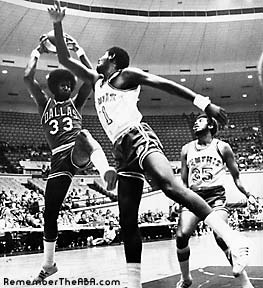 |
The Tams never had very many fans at the Mid-South Coliseum. But those fans who did show up saw their home team wear different uniform combinations every night (in the tradition of Finley's Oakland A's). Above left, George Thompson sports the gold top/white trunks combo. Very stylish. Above right, Johnny Neumann dribbles in the gold top/green trunks combo. At left, Wil Jones and Warren Davis play D in the white top/green trunks combo. Hmmm... Well, at least Charlie O. enjoyed the colors. |
|---|
Finley missed his team's home opener to be with his baseball team. This was a precursor of things to come - after putting the team through his own unique brand of "extreme makeover," he rarely bothered to attend any Tams games (or even keep up with the team's situation). As it turned out, the Tams' home-opening loss was only the "tip of the iceberg" as far as the team's problems.
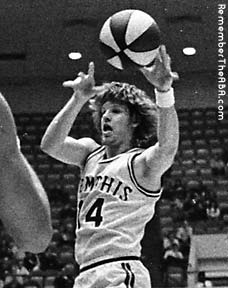 On October 28, 1972, after a series of humiliating defeats (including a 151-98 shellacking at the hands of the Utah Stars in Salt Lake City), the Tams placed temperamental guard Johnny Neumann (right, # 14) on waivers - a shock to both Neumann and the entire league given his long-term, no-cut contract. Coach Bass and Tams' management felt that despite his obvious talent, Neumann's selfish play had contributed to a poor team attitude. Mostly due to his large salary, and partly due to his reputation as a ballhog, no other ABA team was willing to take on Neumann's contract. On November 2, Neumann was recalled to the Tams and vowed to change his game for the better. For at least a few weeks, he did nothing but pass. He had one game with 15 assists, and another with 16. Incredibly, he climbed to 4th in the league in assists per game. Asked about the turnaround, Neumann stated: "When I got the word that I was waived, I was shocked. It shook me up and while I was on waivers I had a long talk with the coach and also my father. The Tams called me back and when I came I was a different player. The coach gave me the freedom to run the club so instead of being the shooter I become the quarterback." Bass was (temporarily) pleased with the attitude change. When asked how the Tams would have dealt with the situation had another ABA team actually claimed Neumann off the waiver wire, Bass gave this mysterious answer: "Mr. Finley and myself agreed that what we would have done will remain a well-kept secret."
On October 28, 1972, after a series of humiliating defeats (including a 151-98 shellacking at the hands of the Utah Stars in Salt Lake City), the Tams placed temperamental guard Johnny Neumann (right, # 14) on waivers - a shock to both Neumann and the entire league given his long-term, no-cut contract. Coach Bass and Tams' management felt that despite his obvious talent, Neumann's selfish play had contributed to a poor team attitude. Mostly due to his large salary, and partly due to his reputation as a ballhog, no other ABA team was willing to take on Neumann's contract. On November 2, Neumann was recalled to the Tams and vowed to change his game for the better. For at least a few weeks, he did nothing but pass. He had one game with 15 assists, and another with 16. Incredibly, he climbed to 4th in the league in assists per game. Asked about the turnaround, Neumann stated: "When I got the word that I was waived, I was shocked. It shook me up and while I was on waivers I had a long talk with the coach and also my father. The Tams called me back and when I came I was a different player. The coach gave me the freedom to run the club so instead of being the shooter I become the quarterback." Bass was (temporarily) pleased with the attitude change. When asked how the Tams would have dealt with the situation had another ABA team actually claimed Neumann off the waiver wire, Bass gave this mysterious answer: "Mr. Finley and myself agreed that what we would have done will remain a well-kept secret."
On November 11, promising young center Randy Denton was placed on the injured-reserve list with a broken hand. Instead of crippling the team, this allowed one of the team's few bright spots - center Lee Davis - to emerge. During the previous three seasons, Davis was mostly a backup, averaging 10 minutes and 4.4 points per game. However, after Denton's injury, he stepped right into the starting lineup, became the third-leading percentage shooter in the ABA (at 56%), and averaged 21 points and 15 rebounds per game. At one point, he scored 38 points against Virginia and 36 against Indiana - in successive games. "I knew I could put the ball in the hole," he said after the Indiana game, "but this is ridiculous." Later, in another game against Virginia, Davis went 10 for 14 from the floor, 4 for 4 from the foul line, had a game-leading 13 rebounds, and blocked three shots (two of them Julius Erving's). This prompted Dr. J to say: "That cat just doesn't miss from anywhere around the key!" In some rare positive publicity for the Tams, Sports Illustrated even did a special article about Davis' surprising resurgence.
Despite these few bright spots, things continued to deteriorate. Whatever good will had existed between Finley and the citizens of Memphis began to deteriorate in early December, when it was learned that Finley had started negotiations with city officials in St. Paul, Minnesota to move the team there.
On December 16th, Denton returned to the lineup and scored 23 points, but it wasn't enough as the Tams lost to Indiana 125-120 - their 14th loss in a row to the Pacers. A short time later, when Denton's wife asked the front office for some pictures of Randy to send to fans, she was told that she would have to pay for them herself.
In some further embarrassing "cost-cutting" efforts, Memphis cut longtime ABA vet Ron Franz right before Christmas, and then waived former Utah Star Merv Jackson on New Year's Day. When Franz arrived at the team's offices to claim his last paycheck, he was told that he would have to turn in his team warmup jacket, duffle bag and suitcase before being paid (Merry Christmas!).
Incredibly, 19 different players performed in the green, gold and white Memphis uniforms the during first half of the 1972-73 season. To illustrate the mess that was the Memphis Tams franchise, 24 separate transactions took place to change the Tams' roster in the two-month period from October 28 through December 28 (involving, in no particular order, such names as Johnny Neumann, Wil Jones, Charlie Williams, Sam Cash, Isaiah "Bunny" Wilson, Loyd King, Bob Ford, Luther Rackley, Merv Jackson, Randy Denton, Les Hunter, Dave "Big Daddy" Lattin, Darel Carrier, Ron Franz, and Mike Davis). Even in the world of the ABA, this type of turnover and change was unheard of - Harvey Kirkpatrick, PR Director for the Utah Stars, wrote: "The whole thing reads like something out of Gulliver's Travels. Finley has set some sort of pro basketball record, if not a standard for all of sport, with the manner which he has added and deleted names from the Tams' roster this season."
| While the Tams lost a lot during the 1972-73 season, these three players always gave their best. They were fan favorites, but played mostly for pride since Tams fans were few and far between.Guard George Thompson (above left, # 23) was a scoring machine. He kept the score close (and every once in a while, pulled out a victory for the team). He averaged 21.6 ppg that season. Center Lee Davis (above right, # 34, with the hook shot over 1972-73 ABA MVP Billy Cunnningham) came into his own during the 1972-73 season. He got a chance to start when Randy Denton broke his hand. Davis went on a scoring tear that even he didn't believe. Cunningham told Sports Illustrated: "Davis has an unstoppable shot! A hook that can't be blocked!" Wil Jones (right # 11, with the jumper over George Carter) was a holdover from the days of the Memphis Pros. His forte was defense and rebounding. With the Tams, he scored a little bit too. | 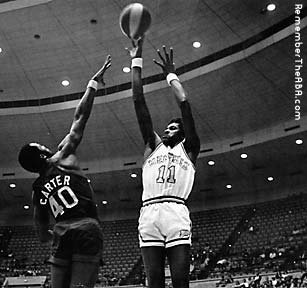 |
|---|
After Christmas the roster became more stable, but the Tams went 8-29 (by far the worst in the league). At first the losses were somewhat competitive - during a 10-game losing streak in January, the ten losses were by a total of 42 points (and only one loss was by more than 5 points). But after February, the Tams became a lost cause. At one point, they lost three games in a row to Carolina and Kentucky (twice) by 20, 30 and 24 points.
In the middle of all the losing (and cost-cutting), Finley took the bizarre step of offering all of the Tams' players, coaches and male front office personnel a special $300 "bonus" to grow a mustache (Finley had taken the same approach with his Oakland A's, resulting in Rollie Fingers' famous handlebar mustache). Coach Bass, trainer Don Sparks, and several players took the offer seriously, grew full mustaches, and hopefully got their promised bonus out of Finley (anyone care to bet on whether Charlie O actually paid the "mustache" bonuses?).
On March 13, 1973, Memphis was mathematically eliminated from the playoffs as the New York Nets clinched the final spot in the Eastern Division. As the Tams played out the string (ending up with a 24-60 record), everyone wondered whether the chaos of the 1972-73 season had finally spelled the end of the ABA in Memphis. As soon as the season ended, the team's office abruptly closed and all telephone lines were disconnected. Coach Bass resigned and joined the ABA's New York office to supervise the league's referees. Finley tried to sell the team a few times (a Providence, Rhode Island group seemed interested for a while). But nothing happened, and Finley spent much of the summer in the hospital recovering from a heart ailment.
As August rolled around, Finley wasn't communicating with anybody about his ABA team. The players? They had no idea what was going on. Warren Davis told writer Jim O'Brien: "No one has told us anything. The office is closed and has been closed for the last two and a half months. My son starts school here in two weeks. That's if we're going to be here." It came down to the wire right before training camp - and still no one had heard from Charlie O. Finally, in late August, Thurlo McCrady (the ABA's executive director in charge of making the league schedule) somehow managed to get word from Finley - the Tams would play. Due to this late decision, the 1973-74 ABA schedule was not released until August 25, less than two months before opening day. In this way, the Tams managed to hold up almost all of the ABA's radio and TV contracts and commitments.
On September 10, 1973, training camp opened for the Tams in Memphis. But there were a few "small" problems. The team had no head coach and no front office, and zero season tickets had been sold. The players reported but could only sit around wondering whether and how to practice. Finally, trainer Don Sparks (apparently the only non-player still on the team's payroll) took it upon himself to run some practices. Finally, on September 11, just two days before their first pre-season game, Finley hired Bill van Breda Kolff to coach the team. Van Breda Kolff had previously coached the NBA Lakers, Pistons and Suns.
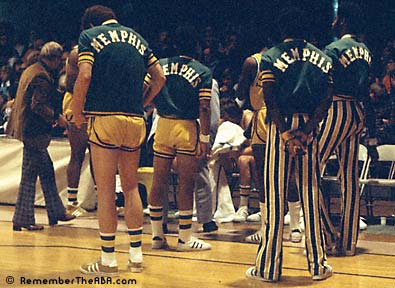 Van Breda Kolff was thrown into an unworkable situation. "We only were able to get in two practices before we played five exhibitions (all with the Denver Rockets)," Van Breda Kolff noted. "In some ways it was hard to step into a situation like this, in other ways it was easy. By the time I arrived the players were ready for some serious coaching." After struggling through the exhibition season, the Tams opened league play in Salt Lake City and almost knocked off the powerful Stars, losing 111-109 in the closing seconds.
Van Breda Kolff was thrown into an unworkable situation. "We only were able to get in two practices before we played five exhibitions (all with the Denver Rockets)," Van Breda Kolff noted. "In some ways it was hard to step into a situation like this, in other ways it was easy. By the time I arrived the players were ready for some serious coaching." After struggling through the exhibition season, the Tams opened league play in Salt Lake City and almost knocked off the powerful Stars, losing 111-109 in the closing seconds.
The core of the 1973-74 team was basically the same as the year before. George Thompson, the rugged veteran, was still the team's best scorer - he always tried hard. Johnny Neumann was still the team's guard. He showed some flashes of brilliance, although he seemed to pass less and less. Randy Denton, Wil Jones and Lee Davis formed a decent front line capable of grabbing a lot of rebounds. The only problem with this group was . . . nothing had really changed. There were the familiar contract squabbles, an absent and disinterested owner, few fans, and many losses.
Early in the season, van Breda Kolff recognized his team's lack of quickness and tried to de-emphasize the fast break. As with many poor teams, the acknowledged strategy was to "control the tempo and lull our opponents into our pattern type game." The slow-down approach didn't really work, and the frustration showed. Van Breda Kolff picked up a team-record four technical fouls in an early season game with Carolina. The team started out a "respectable" 5-9, but then went on several long losing streaks. On December 28, 1973, the Tams broke a 13 game losing streak with a 96-95 win against the San Antonio Spurs. And on February 14, 1974 against the Virginia Squires, the Tams broke a 12 game losing streak with a 106-104 victory. One night later, they beat the Denver Rockets to make it two victories in a row--matching their longest winning streak of the season.
| Given the circumstances, it was incredible that the 1973-74 Memphis Tams stayed in business. The problems starting in training camp, and the team struggled mightily to make it through the season. Coach Bill van Breda Kolff and his players tried to make the best of things.Here are some rare color photos from some 1973-74 Tams home games. George Thomspon (above left, #23, floating over Tim Bassett), played up to his usual high standards. Despite some early season contract issues, and the slow-down style of the team, he averaged 19.2 points and even made the ABA All-Star Team. Center Randy Denton (above right, #32, going against the Squires' Jim Eakins) was fierce on the boards and had a nice afro (to go along with the yellow low-cut sneakers - check them out!). He averaged 13.3 points and 9.8 rebounds per game. Glen Combs (right, # 20, guarded by former teammate Jimmy Jones) was intended to be the replacement for Johnny Neumann. He came to the team in a trade with the Utah Stars in late January 1974. Coming from the Western Division-leading Stars to the Eastern Division doormat Tams was a difficult adjustment. Injuries prevented him from really helping the Tams (and they were too far gone to be helped in any event). | 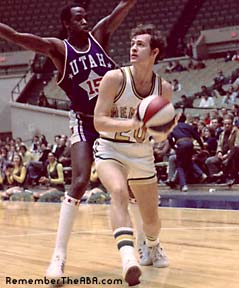 |
|---|
Finley did not bother to attend any games during the Tams' second season (sometimes going for weeks without communicating with van Breda Kolff about roster moves and team business). However, he did implement some new cost-cutting measures. For example, he took the unique approach of eliminating the publication of game programs for home games. Tams fans had to make do with typed, mimeographed lineup sheets instead (these, at least, were free). Memphis fans - sensing the futility of the entire operation - stayed away in droves. The lack of attendance late in the season approached the lows only previously seen in the ABA with the 1968-69 Houston Mavericks.
In late December, van Breda Kolff candidly described the situation to Bernie Beglane of Basketball News:
I can pick a set lineup for the rest of the season and stick with it the remainder of the season, and hope we can somehow get back to winning. Of course that would make two or three guys unhappy, but I can't worry about that. My job is to run a ballclub. If that doesn't work, then I get rid of some people and hope to find better. Then again, there's a problem ... where do I get them? Really, I'm undecided, but things can't go on like this. Common sense dictates that something has to be done. If a regular business was in this kind of bind, changes would be made. The people of Memphis would come out if we had a decent club. They want to see a team that is exciting and quick. We used to be that way, but now... I feel like we could have a solid franchise here in Memphis if we had the right backing. The fans would support us if we were presentable. People here in the city talk about buying the club, but so far I haven't seen any money. They tell me Elvis Presley has been approached. He's from Memphis, but is more interested in a football franchise. I feel I could convince Elvis about basketball if I could meet him. I'm working on that right now.
The "Elvis" option never panned out. On January 30, 1974, van Breda Kolff was able to make one major trade - he shipped Johnny Neumann to the Utah Stars for Ronnie Robinson (a local favorite from Memphis State), Mike Jackson and Glen Combs. The local popularity of Robinson increased attendance for a few games (incredibly, over 5,000 fans turned out for his first appearance in a Tams uniform). But things quickly went back to normal and the losing continued unabated. The Tams limped through the end of the season and ended up winning only 21 games. Finally, after two years of operating an ABA franchise as only he could, Finley bailed out and the league took over the franchise.
Was this finally the end for Memphis in the ABA? Amazingly enough, no, as another new ownership came into the picture (headed by ABA Commissioner Mike Storen and Stax Records), and gave the operation one more try - and one more season - as the Memphis Sounds.
Tams Fan Memories
TAMS YEAR-TO-YEAR RESULTS
1972-73 Memphis Tams
Record: 24-60, Fifth Place in Eastern Division
Missed Playoffs
1973-74 Memphis Tams
Record: 21-63, Fifth Place in Eastern Division
Missed Playoffs
1974-75 Under New Management (Memphis Sounds)
Thanks to John G. Schmitz and Kevin McMahon for their valuable contributions to this page.